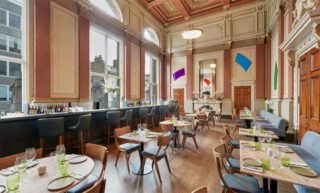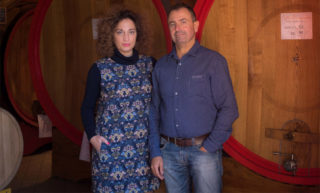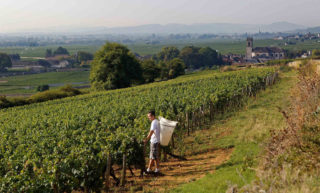Tradition and modernity in La Rioja
La Rioja is often mentioned in the same breath as Bordeaux. Even before phylloxera hit the latter, French vintners and traders were active in the Rioja. Parallels between the two regions are hence not uncommon. After expansion of the wineries, and the entire Denominacion de Origen (DO), in the 1980s and 1990s, now there is a clear trend back to smaller wineries, sustainability and focus on terroir.
On a recent visit, we spoke to four vintners representing a cross-section of what is old and new in the most iconic of Spanish wine regions: a winery with roots in the French era and one which goes back to the last part of the previous century, plus two younger vintners, one championing the Burgundy way of making wine and the other seeing himself as representative of the small vintners from the pre-phylloxera days.
Perched next to each other on the banks of the Ebro River in Haro, the central hub of the western part of the Rioja, the venerable cult winery Viña Tondonia of the López de Heredia family, founded in 1877, and the Roda winery of the Catalan couple Mario Rotllant and Carmen Daurella, founded in 1987, are worlds apart. Both bodegas (or wine cellars) feature an impressive, more than 100-meter long corridor, dug out in the sandstone embankment by Basque mineworkers in the 1890s, which opens up to a natural terrace overlooking the river and the famed Gravonia vineyard on the other side, but that is likely where the similarities stop.
Inspired by Tradition
Tondonia, after which their top wine and the winery itself are named, is a vineyard in a hairpin bend of the Ebro just outside Haro. If not by terroir, the winery is driven by its heritage.
An impressive feature of Viña Tondonia, that proves the point, is its traditional, on-site cooperage. Tondonia shuns mechanisation; All twelve thousand barrels in their cellars were made here by hand. With his horn-rimmed glasses, José Mari Saez Morón looks more like a professor than a cooper who has been with the firm for 25 years. Under his guidance the seasoned wooden planks are shaped into barrels, the lids made water-tight, or should I say wine-tight, by natural reeds from the Ebro. To minimize the influence of wood and let the terroir stand out, the barrels aren’t toasted; heat is only used to bend the planks.
Barrel in the making
Tondonia uses enormous old oak vats that are lined with historic, natural yeasts that trigger the traditional, yet again fashionable, spontaneous fermentation. The temperature in the fermentation room is controlled by natural air only. In earlier days they used small woodstoves to increase the temperature to around 21°C to trigger the second or malolactic fermentation that takes place during the cold winter months. The pressed juice is filtered with a bunch of vine branches.
The pomace goes back into the vineyard. Although viticulture isn’t fully organic, Viña Tondonia strives to work in an ecologically responsible way, not in the least because the quality of the grapes benefits from it. To underline their commitment, Mercedes López de Heredia, the current fourth generation winemaker allows her children to study anything but chemistry.
Wines typically age very long at Tondonia. To avoid excessive oxidation, López de Heredia uses mostly American oak, known for its dense pores. For the same reason, she prefers to use cork from wild Catalan, rather than Portuguese oak trees to close the bottles.
After barrel aging, often longer than the DO requires, the wines are blended in vats of 64.000 liter that are 1977 replicas of the originals. Within the rules of the DO, López de Heredia allows for blending different vintages, except for the Gran Reservas. The resulting wines are complex and multi-layered, and in their age-worthiness vaguely reminiscent of old style Bordeaux.
Blending barrels at Viña Tondonia
Just like the Viña Tondonia, the Bosconia and the Gravonia wines are named after their vineyards and are expressions of their location. Nonetheless, small details still refer to their French heritage. In commemoration of the fact that Bosconia used to be a Pinot Noir vineyard, until López de Heredia bought it, the eponymous wine is bottled in Burgundy-style bottles. The 2006 vintage we tasted, in glasses designed by Mercedes’ father, opened up quickly, was full of cherries and red fruit and had fine tannins.
Originally planted with Semillon and Sauvignon Blanc, the emblematic grapes of the Grave near Bordeaux, The Gravonia vineyard borrowed its name from this French region. Now it’s completely under native Viura vines.
Vintage wines
While Viña Tondonia, treasuring its history and traditions, lets the black mold and spider webs grow freely in their cellars, all in a quest to create a bug-free and naturally climate-controlled environment, the cellars at Roda on the other hand are modern and utterly clean, bringing to mind the almost sterile atmosphere of a hospital.
Their winemaking philosophy is, unsurprisingly, dissimilar. “When the wine is aging in new to three-year-old French oak barrels, we take monthly samples that undergo a chemical analysis and a sensory test”, our private guide Edurne explains. “The wines with a taste profile dominated by red fruit are allocated for the Atlantic Roda label. If the flavors lean towards black fruit, the wine is assigned to the Mediterranean Roda I label.” Although it is permitted under the Rioja DO to blend wines from different years, Roda doesn’t do so. Roda farms 28 vineyards of mostly old vines, as much as possible without chemicals; however, only selected grapes from the seventeen best vineyards, which can be different each year, are used for their wines. The rest is sold. Their wines, all of them top class, are essentially an expression of the vintage, or put differently the weather and other conditions in a particular year.
It's clean at Roda's
The weather is a complex phenomenon in the huge Rioja region. Stretching out for 140 kilometers along the meandering river Ebro from Haro in the west to Alfaro in the east, the western side of the DO is wedged in between the eastern reaches of the Sierra Cantabria on the north side and the snow-capped mountains of the Sierra de la Demanda on the south side. Towards the east the Ebro valley widens and the mountains give way to flatter, more alluvial lands. This geography defines the climate. While the eastern half, Rioja Baja, or Rioja Oriental as it is currently called, is more exposed to the summer heat that flows in from the Mediterrenean through the Ebro valley, the western side is, despite the protection of the Sierra Cantabria, more prone to cool and wet Atlantic conditions. When the weather comes from the interior (the south), the entire area may experience continental extremes: harsh cold in the winter or dry heat in the summer.
Ebro Valley and snow-capped Sierra de la Demanda
Each family is a DO
Winemaking in the Rioja took off when phylloxera hit France and wines from the Ebro valley had to compensate for falling harvests in Bordeaux. This, as a matter of fact, was the start of Viña Tondonia. The Rioja is traditionally a region of farmers who sold their grapes to larger winemakers or whose families made rustic table wines. From the 1980s the average size of a viable grape farm started to rise and new vines with higher yields replaced many of the old ones. The vast majority of the wines are still produced by a limited number of large companies. Against this backdrop Olivier Rivière and Roberto Olivan started developing their wineries in the first decade of the millenium.
Roberto Olivan
Roberto, the owner of Tentenublo, builds on the tradition of the small family winery. He is a “vigneron” in the traditional sense of the word, somebody who grows his own grapes and makes his own wine, in Roberto’s case often field blends. The wines have to be sold and the tanks and barrels need to be empty again before the next harvest. His wines thus never get more than approximately eight months of barrel aging. His grandfather is his point of reference, but his way of winemaking hails back to times way before Phylloxera and the French “invasion”. He ferments his wines in concrete tanks, because that is what his grandfather used to do. Stainless steel didn’t exist, barrels were rare and usually made of chestnut rather than oak and amphorae he finds too trendy. Although Roberto is strongly attached to his vineyards – all situated around the village of Lanciego – continuing the family tradition is his hallmark. “Ideally the Rioja DO should have grown out of these small pockets of characteristic wine rather than being established as a large area with all its diversity right from the start.” “Each family is a DO”, he continues, to differentiate himself from the vast Rioja DO. He certainly is a savvy marketeer. His entry level Xerico always has a portrait of a family member on the label. Each bottle of his single vineyard wines is neatly waxed, hand-labelled, hand-wrapped in wafer-thin paper and fitted with a small card tied around the bottleneck.
Terroir-driven
On the face of it, Olivier Rivière doesn’t seem to be a feet-in-the-mud type of vintner when he arrives at his winemaking facility in Laguardia in a flashy grey Mercedes and in his Hogan shoes and Porsche bodywarmer. It is the inevitable trap of appearance. Being a Frenchman in a classic Spanish wine region doesn’t disrupt him, or anyone else for that matter. When he came to Spain to work for the famed Remelluri winery, he fell in love with the old vines that where rapidly disappearing. He now owns ten hectares and leases another twenty. Leading by example, he tries to convince farmers who work for him to shift to organic farming, which, according to Rivière is a hard sell in the Rioja. In the same vain as Burgundy, where he trained, his philosophy is to create single vineyard and village wines with respect for the terroir. He doesn’t grow Pinot Noir though, but rather the traditional Rioja varieties: Tempranillo, Garnacha, Mazuelo (the local name for Carignan) and Graciano for his reds, and Viura, Malvasia and Garnacha Blanca for his whites, from which he makes wines with great precision, freshness and complexity. Just as Roda, he doesn’t use American oak, which became popular in the course of the twentieth century due its lower price, but French oak. His wines thus lack the typical sweet vanilla notes of new American oak. As a member of Rioja ‘n’ Roll, a group of seven small to medium-sized vintners, he tries to “make noise”, as he says, to attract attention for their new way of winemaking.
Oliver Rivière's wines
Apart from Rioja ‘n’ Roll, Rivière says he knows several other small vintners who follow their own path. Quality-focused, terroir-driven, sustainable farming, low yields and elegant rather than big-bodied are the buzzwords of modern Rioja. The times that Bordeaux was the only mold in which the Rioja wines were cast is over. Tradition and modernity live side by side now and in each segment you will find fantastic wines.
R. López de Heredia Viña Tondonia
Av. Vizcaya 3 – Haro
visits on request only
E: visitas@tondonia.com
T: +34 941 310 244
Bodegas Roda
Av. Vizcaya 5 – Haro
visits on request only
E: visitas@roda.es
T: +34 941 312 187
Tentenublo
C/La Fuenta 52-54 – Lanciego
visits on request only
E: info@tentenublo.com
T: +34 699 236 468
Olivier Rivière
visits on request only
E: olivier@olivier-riviere.com
A Norwegian adaptation of this article was published in the May 2019 issue (print) of Apéritif magazine.







Comments